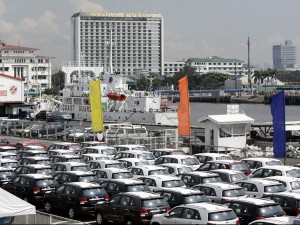Imports eased to $61.7B in 2013 on electronics slump

Hundreds of imported cars mostly from Japan and South Korea are parked waiting for deliveries at a Manila pier on Nov. 10, 2011. AP FILE PHOTO
MANILA, Philippines—The country’s imports contracted in 2013 as weak global demand prompted export-oriented firms to purchase less foreign-made inputs.
The Philippine Statistics Authority (PSA) reported Tuesday that total imports for the year amounted to $61.71 billion, down year on year by 0.7 percent.
For the month of December, imports fell 0.1 percent to $5.29 billion as electronics shipments shrank 7.3 percent to $1.19 billion during the month.
The drop in Philippine imports followed a relatively weak global demand, especially for non-essentials like electronics. This pushed export-oriented firms in the country to import less inputs for production. Economists said that in times of economic uncertainties, consumption tend to focus more on basic goods and less on non-essentials.
Raw materials and intermediate goods, led by electronics, accounted for nearly 40 percent of the total import bill in December, while capital goods composed nearly a fourth.
Economic Planning Secretary Arsenio Balisacan, director general of the National Economic and Development Authority (Neda), earlier said that domestic demand, both from consumers and investors, was robust.
However, sluggishness of the external environment pulled down imports.
The contraction in imports in 2013 was way off the government’s official target of a 12-percent increase.
Balisacan, however, expressed confidence that global demand would rise this year. As such, Philippine imports could jump as well. Under the 2014 macroeconomic assumptions of the government, imports are expected to rise 6 percent this year.
The biggest import products in December 2013 after electronics were mineral fuels, lubricants and related materials (up 34.7 percent year on year to $1.19 billion), transport equipment (down 12.1 percent to $662 million), industrial machinery and transport equipment (down 9.2 percent to $264.68 million), and cereal and cereal preparations (up 65 percent to $159.76 million).
China was the biggest source of imports in December at $776.49 million, up 30 percent year on year. The United States followed, accounting for $575.79 million (down year-on-year by 31 percent). Other top sources of imports for the month were South Korea (up 10 percent to $422 million), and Japan (down 11 percent to $405 million).
Meantime, the PSA also reported that combined imports from other member-countries of the Association of Southeast Asian Nations (Asean) amounted to $1.2 billion, up year-on-year by 7.3 percent
Policymakers are urging the private sector to expand trade with other Southeast Asian countries to aid in the realization of the an integrated Asean economy.
Under the Asean integration framework, Asean is intended to be marketed to foreign investors as a single bloc rather than individuals countries. Also, barriers to the free movement of goods, labor and investments within the region are intended to be lifted.
The original target for the implementation of Asean integration was 2015. However, policymakers now believe that while member-countries may meet some of the requirements of integration by 2015, full integration will not happen until 2020.—Michelle V. Remo